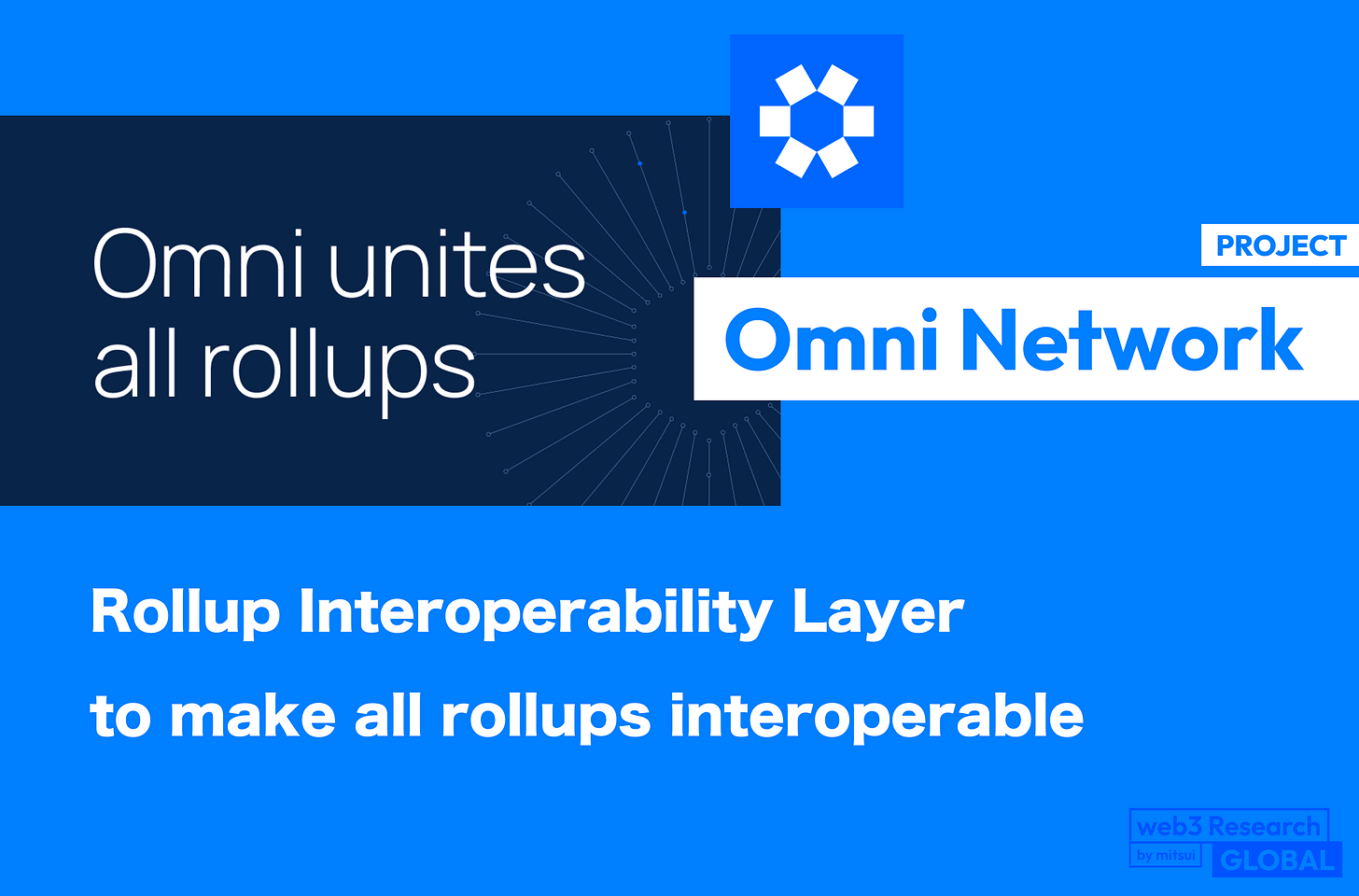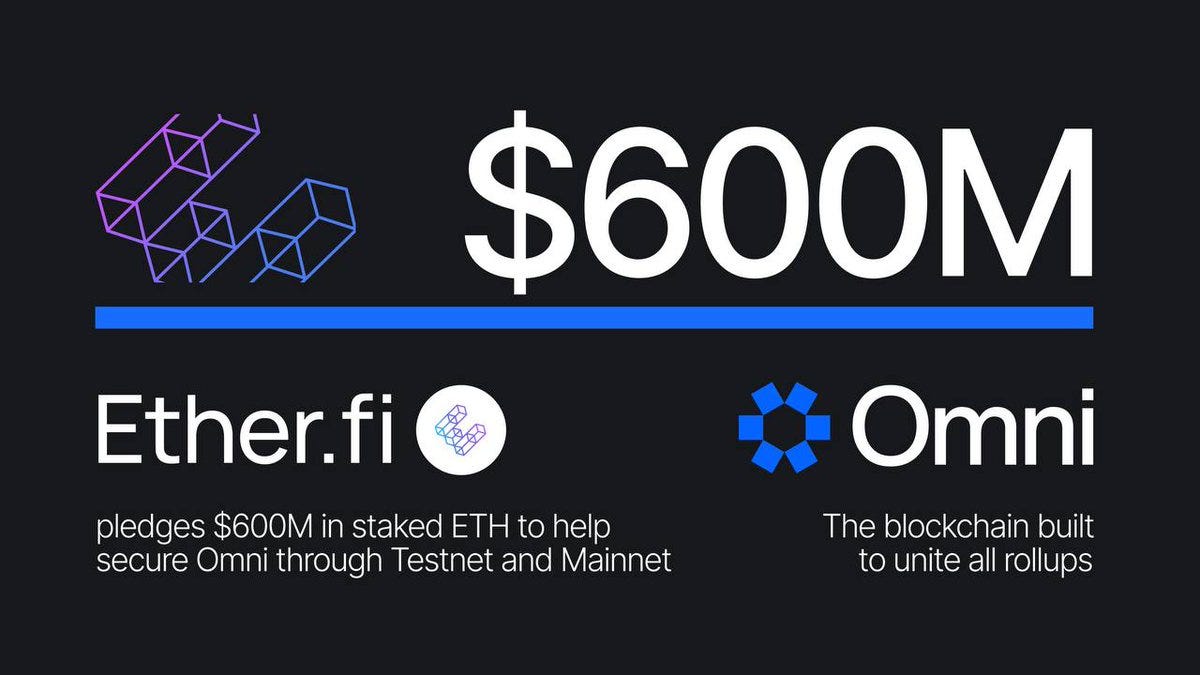【Omni Network】Rollup Interoperability Layer to make all rollups interoperable / Dual security model with EigenLayer and own tokens / Genesis drop underway / @OmniFDN
"Omni Network" is a modular blockchain that aims to integrate all rollups into an interoperable network.
Good morning.
This is mitsui from web3researcher.
Today we researched the Omni Network.
🧩What is the Omni Network?
⚙How the dual-staking model works using cross-messaging infrastructure and EigenLayer
💧$OMNI Token Economics and Utility
👟3 test nets and finally the main net is open to the public
💬A future where everything is done within Ethereum?
🧩What is the Omni Network?
The "Omni Network"is amodular blockchain designed to integrate all rollups into an interoperable network.
Currently, the main stream of scaling solutions for Ethereum are rollups, although there are two directions: an Optimistic Rollup centered on Arbitrum and Optimism, and a zk Rollup centered on Polygon and Scroll. Ethereum has laid out a rollup-centric roadmap.
Certainly the rollups have greatly reduced transaction gas costs and contributed significantly to Ethereum's scale.
On the other hand, the fragmentation of assets is noticeable as L2s based on rollups are disrupted. Until now, fragmentation between blockchains has been conspicuous. With the single strengthening of Ethereum with the development of rollups, fragmentation between each rollup has become an issue.
For example, how can tokens or NFTs issued by Arbitrum be transferred to Optimism? The reverse is also true, and fragmentation of assets among other rollups is also a problem. Fragmentation of each rollup results in a lack of user experience, poor developer experience, poor asset liquidity, poor security, etc.
The "Omni Network" unifies Ethereum's fragmented Layer 2 ecosystem by establishing a low-latency, high-throughput global messaging network for all rollups.
It is aroll-up interoperability layer for Ethereum. Developers can build Dapps on the "Omni Network" to extend to their respective rollups.
⚙ How the dual staking model works using cross-messaging infrastructure and EigenLayer
This is followed by an explanation of how the "Omni Network" works.
If I start to explain in detail, it will become difficult with technical terms, so I will explain only briefly here. If you are interested in the details,please refer to thedocumentation.
The Omni Network consists of the following five components
Rollup Networks
Omni Network
EigenLayer restaking contracts
Omni Portal contracts
relayers
The actual flow is easy to understand as shown in the following diagram: Messages (transactions) sent from Rollup A are sent as XMsg to the Omni Network via Portal contracts ("Halo" is the consensus client in the Omni Network, but this is difficult to understand. (Halo is a consensus client within the Omni Network, but since this part is difficult to understand, it is fine to understand that XMsg is sent to the Omni Network for processing). Then, the message (transaction) is sent to Rollup B via "Relayer".
Very simply put, it is like doing a cross-chain process within the "Omni Network.
And even more distinctive is the use of a "dual staking model of restaking using EigenLayer and DPoS using $OMNI tokens.
The "Omni Network" is borrowing security from EigenLayer as an AVS. It has already been selected to receive $1B worth of support from major liquidity re-staking token providers such as EtherFi, Swell, Kelp, EigenPie, and Bedrock.
↓ Below is the announcement of the $600M support decision from Ether.fi.
In addition, it issues its own token, $OMNI, which employs a consensus algorithm called CometBFT and has its own validator.
This approach not only allows Omni to inherit Ethereum's vast security resources, but also to expand its security budget over time as more $OMNI tokens are staked.
💧Economics and utility of $OMNI tokens
$OMNI is a native token that enhances the Omni Network. It is used for security enhancements and governance, but can also be used as utility gas money between each rollup.
For example, if both Rollup A and Rollup B use $ETH as gas, they cannot share their respective $ETH. $OMNI is the digital lubricant of the Ethereum rollup ecosystem, simplifying gas payments between rollups.
Supports payment by native tokens of the originating network; internally, payment tokens are converted to $OMNI and paid to the relayers processing transactions in the destination network on behalf of the user. It is also possible to set $OMNI as a gas payment.
The total supply is 100 million tokens to be distributed in the following allocations
For each stakeholder, it is gradually released over a period of approximately three years.
There is currently a 45-day Genesis airdrop event beginning April 17, 2024, with $3,000,000 (3% of total supply) being distributed in the following allocations
👟After 3 test nets, the main net is finally open to the public.
The "Omni Network" is currently under test-netting, and this is the third test-netting. We have been gradually expanding the functionality of the system and conducting tests.
Omni Origins (August 2023)
Experience earning tokens for participating in missions and earning yields on yield-farming applications
More than 1.5 million transactions and 150,000 users
Omni Overdrive (August~November 2023)
Enables development of dapps for Linea, Arbitrum, and Scroll
More than 4 million transactions and 360,000 users
Omni Omega (March 2024)
Four phases, with the last being the test net.
Phase 1 will focus on re-securing and bootstrapping security, allowing operators to delegate ETH, stETH, rETH, cbETH, and bwETH to Omni via EigenLayer
Phase 2 will allow users to delegate ETH re-staked on test nets to Omni via EigenLayer
Phase 3 will focus on interoperability and passing cross-rollup messages between Arbitrum and Optimism; Phase 4 will allow users to deploy contracts to Omni's EVM and pass messages between Optimism, Arbitrum, and Omni EVM Messages will be able to be exchanged between Optimism, Arbitrum, and Omni EVM
Main net to be released by the end of 2024.
Thus, the Omni Network, which is currently in its final test net and attracting a lot of attention, will also introduce investors and its current ecosystem.
Investors have completed an $18M raise from Pantera Capital and others in April 2023.
The ecosystem is a gorgeous one, with L2s such as Arbitrum, Optimism, Polygon, and Scroll, as well as modular systems such as EigenLayer, Espresso, and AltLayer.
💬A future where everything is completed within Ethereum?
The last is a consideration.
While the fact exists that Ethereum's L2 is gaining momentum, attention has recently focused on the DA layer, interoperability layer, and other chains and protocols that will be needed in the future after L2 is widely used.
Considering that Arbitrum and Optimism started to spread 2~3 years after the main net started operating around 2021, it still takes time for the technology to penetrate. Since it has been 2~3 years since it was on the table, considering the conception and test nets, it will take at least 5 years for the new technology to spread.
Then, the "Omni Network" will be out in the open as a test net from 2023, and the main net will be open to the public in 2024, so we can expect full-scale penetration around 2025~26. Personally, I believe that mass adoption is finally approaching in this area, so in a future where ethereum itself has been updated and L2 technology has advanced to achieve scalability that can withstand mass adoption, the "Omni Network" may increase its presence as a function to solve the interoperability problem.
That said, Ethereum is still strong. With the recent rise of emerging L1s such as Solana, Aptos, and Sui, as well as Bitcoin, it is no longer clear whether Ethereum will continue to be the only strong one.
However, I personally believe that with such a strong ecosystem and developers, Ethereum will continue to be the majority giant in the blockchain ecosystem unless some serious flaw is found or occurs in the future.
With this in mind, it is easy to see why the Omni Network, which solves the interoperability of the Ethereum L2 rollup, is so important and has attracted so much attention.
We are very excited that the main net will be open to the public in 2024.
This is the research for the Omni Network!
🔗Reference/image credit:HP / DOC / X / Medium
Disclaimer:I carefully examine and write the information that I research, but since it is personally operated and there are many parts with English sources, there may be some paraphrasing or incorrect information. Please understand. Also, there may be introductions of Dapps, NFTs, and tokens in the articles, but there is absolutely no solicitation purpose. Please purchase and use them at your own risk.
About us
A web3 newsletter delivered in five languages around the world. We deliver various articles about web3, including project explanations, news and trend analysis, and industry reports, every day. You can subscribe for $8 per month ($80 per year) and receive research articles that took 100 hours to complete every day.
Author
mitsui
A web3 researcher. Operating the newsletter "web3 Research" delivered in five languages around the world.
Contact
The author is a web3 researcher based in Japan. If you have a project that is interested in expanding to Japan, please contact the following:
Telegram:@mitsui0x
*Please note that this newsletter translates articles that are originally in Japanese. There may be translation mistakes such as mistranslations or paraphrasing, so please understand in advance.












